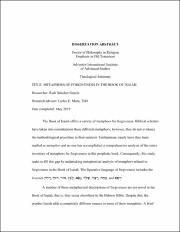| dc.description.abstract | The Book of Isaiah offers a variety of metaphors for forgiveness. Biblical scholars
have taken into consideration these different metaphors; however, they do not evidence
the methodological procedure in their analysis. Furthermore, rarely have they been
studied as metaphor and no one has accomplished a comprehensive analysis of the entire
inventory of metaphors for forgiveness in this prophetic book. Consequently, this study
seeks to fill this gap by undertaking metaphorical analysis of metaphors related to
forgiveness in the Book of Isaiah. The figurative language of forgiveness includes the
lexemes מ , חהָָרצהָ ,שָׁלַךְ , נ ש ָָׂ א , לןָ ,ב סֵ רו, וּ ד , חרַָחץַ , and . רָפאָ
A number of these metaphorical descriptions of forgiveness are not novel in the
Book of Isaiah, that is, they occur elsewhere in the Hebrew Bible. Despite this, the
prophet Isaiah adds a completely different nuance to some of these metaphors. A brief
survey of these metaphors is undertaken in Chapter 1. This study utilizes Eva F. Kittay’s
perspectival theory of metaphor to analyze the multifaceted metaphors of forgiveness in
the Isaianic passages. Kittay provides the methodological basis on how to identify a
metaphor. One of the fundamental tenets of this approach is the analysis of the semantic
incongruity that helps to detect if a grammatical utterance is a metaphorical utterance.
The semantic incongruity or the anomalous nature of the sentence results from the
association of terms from different semantic fields (for example, animate being with an
inanimate object). Moreover, Kittay’s terminologies, the vehicle and the topic, that
constitute a metaphor are integrated in this study. This theoretical framework is posited in
Chapter 2.
Chapter 3 offers the metaphorical analysis of the metaphors. First, the
identification of the metaphor is considered. Second, textual-critical issues are carried out
in order to locate the presence or absence of the metaphor in ancient versions. Third, a
poetic analysis to examine the different kinds of parallelism (grammatical, semantical,
lexical, and phonological). Fourth, the discussion of the metaphor offers valuable analysis
of each metaphor outside and inside of Isaiah.
The previous chapter paves the theological implications that are presented in
Chapter 4. Mainly, it considers the metaphorical theology of the seven metaphors. Lastly,
Chapter 5 offers the summary, conclusions, and recommendations for further study. | en_US |

